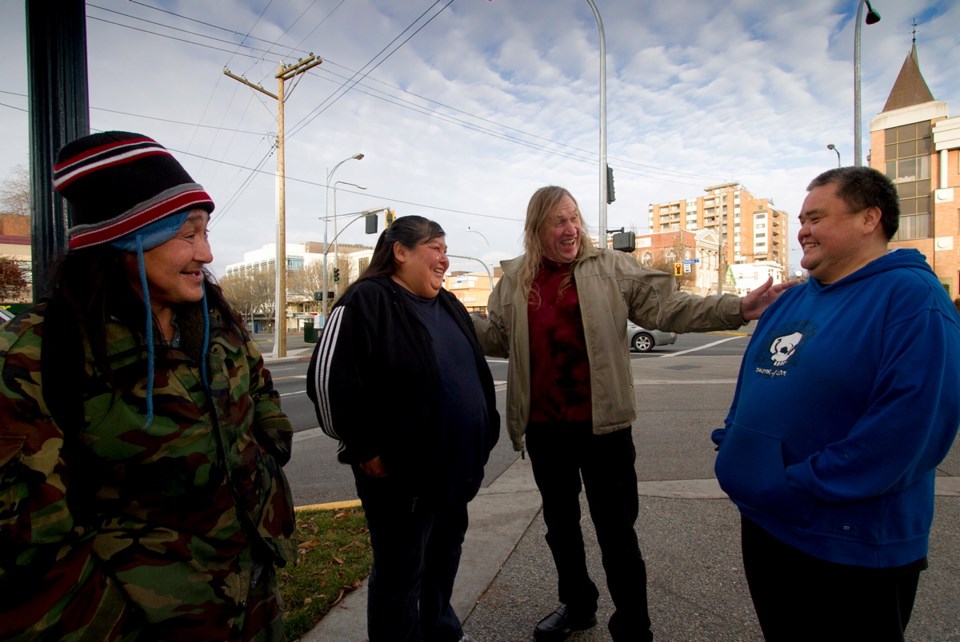More people will be sleeping on the streets and in parks as winter shelters close this week in Greater Victoria — and many have started planning what to do, advocates for the homeless say.
“Some have found places to couch surf and we’re giving out tents, reminding everyone where it’s legal to camp,” said Joann Connolly, seasonal shelter co-ordinator for Cool Aid Society.
Connolly runs the seasonal shelter in the Downtown Activity Centre on Pandora Avenue. The shelter provides up to 46 mats in a gym for homeless people to sleep on from November to the end of March. This is in addition to the 125 permanent shelter spaces Cool Aid offers.
“I’m sure we’ll see an increase in people on the street,” she said, noting the seasonal shelter saw about 240 people over the season, the majority of whom were men between the ages of 45 and 54.
“We did see an increase in women this year,” said Connolly, citing the new location as more open and comfortable. The shelter was previously located in the crypt at the Church of St. John the Divine.
The Victoria Extreme Weather Protocol shelter program also closed at the end of March, meaning dozens of extra beds for youth, men and women on severely cold or wet nights will not be available until next fall.
“This season began fairly normal, but from January on was exceptionally mild,” said co-ordinator Jen Bacon.
The shelter program, which operates out of seven centres around the city, was enacted on 26 nights from November to April, with only five of those this year.
Bacon said although it was a quiet year for the program, they were able to distribute 150 sleeping bags that were left over from the Canada Winter Games in Prince George and donated through the Red Cross.
Rev. Al Tysick from the Dandelion Society gave the sleeping bags out on his daily rounds, when he provides coffee, muffins and essential items to homeless people on the streets.
He said shelter closings and reduced hours will push more people to sleep in parks and on the streets because they have nowhere else to go.
“I’m seeing around 100 people every morning already. Everybody is asking for tents,” said Tysick, who orders tents, tarpaulins and sleeping bags wholesale by the hundreds to hand out.
“Tents are expensive, but I can get a good tarp for $5 at Canadian Tire which can last someone a little while outside.”
Tysick said the items are crucial to helping people survive and stay healthy outside, but are just a Band-Aid solution to a dire lack of housing supports in the city.
“The lousy thing is it costs a lot less money for people to be housed than homeless. The feds and the province really need to come to the table on this,” said Tysick, noting the city is doing what it can.
Victoria city councillors discussed a report this week that said people seeking shelter in city parks and streets are a serious drain on resources and finances. Bylaw officers and police said they spent hundreds of thousands of dollars in 2014 dealing with people “sheltering” in parks. Councillors agreed to look at short- and long-term solutions to the problem.
Grant McKenzie, of the Our Place Society, said he expects to see more homeless people using the drop-in centre to sleep during the day because they don’t feel safe on the streets at night.
“It can be dangerous, so people stay up all night then crash on the chairs here,” he said.
Our Place extended its hours during the winter but has reduced them for the summer months. It will now be open 7 a.m. to 6 p.m. on weekdays and noon to 6 p.m. on weekends.
McKenzie said Our Place will still serve lunch and dinner every day.
“We saw a dramatic increase in need for meals,” he said. In 2014, Our Place served 525,000 meals, up from 340,000 in 2013.
“Moving dinner up to 5 p.m. [from 4 p.m.] brought in a lot of the working poor who have to choose between food and rent,” McKenzie said.



